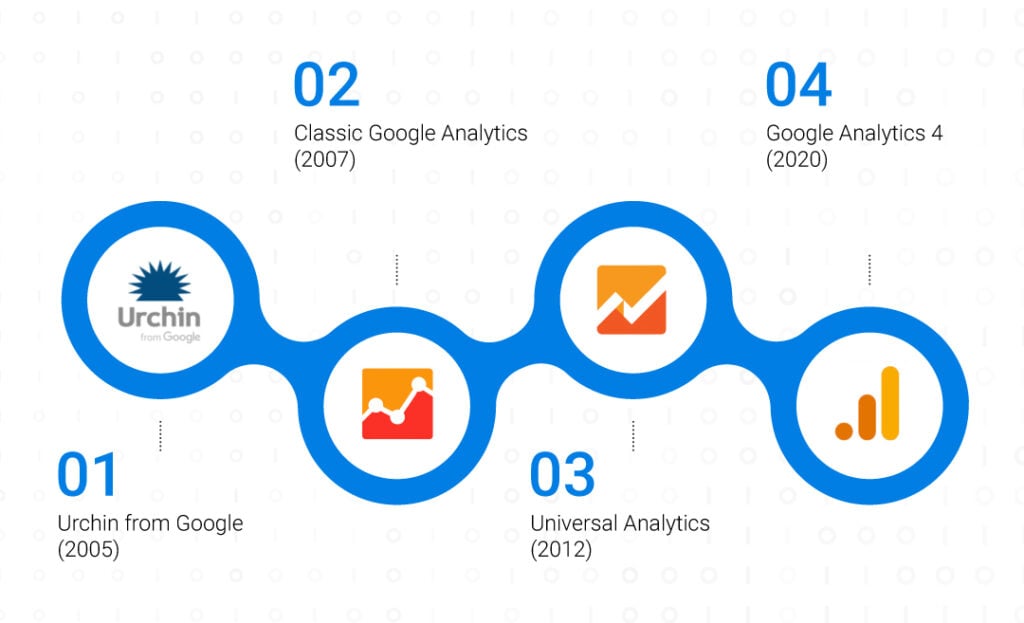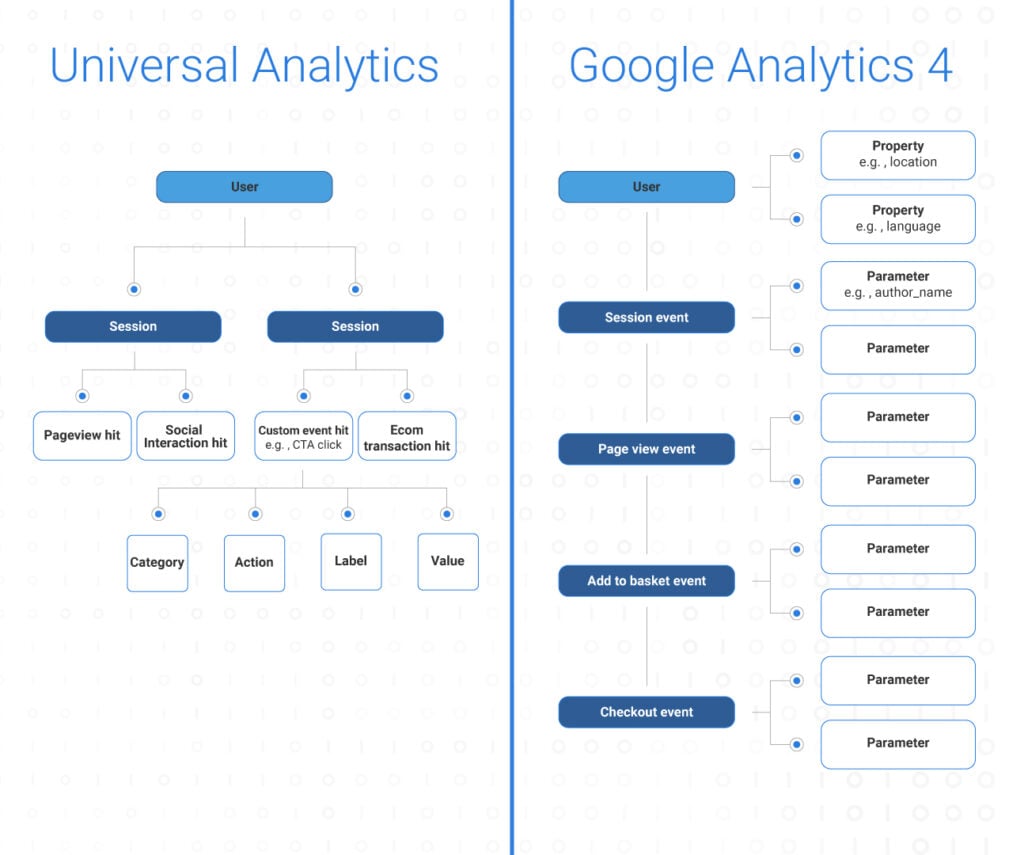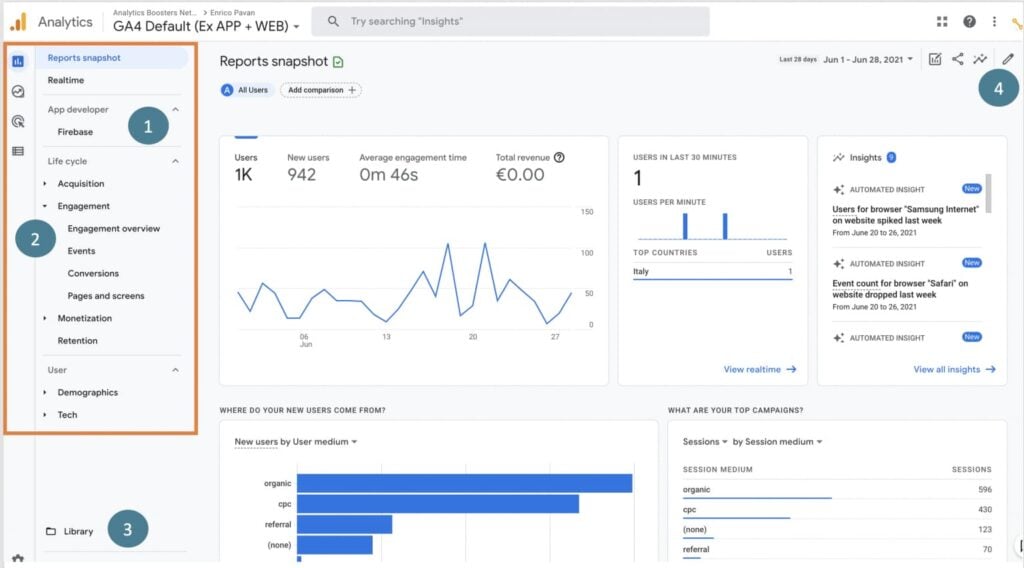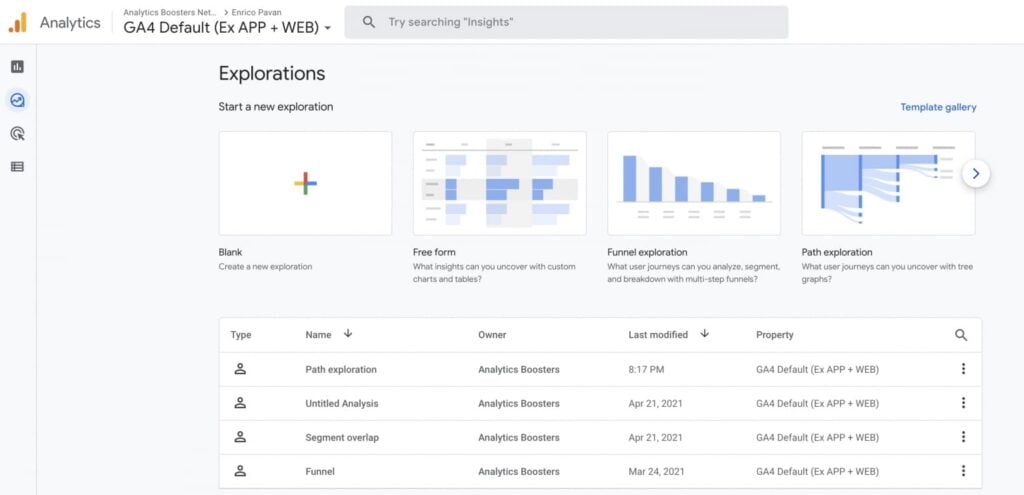Table of Contents
Google has announced that by June 2023, it will be retiring Universal Analytics, the third iteration of its analytics platform. For those that have not yet made the switch – the sooner you get on board, the better.
To most marketers, the evolution has been long overdue. Like any good sequel, Google Analytics 4 is bigger, better and more logical. The platform offers up more room for customisation, more insights and more adaptability. While this is great news for users, there are a ton of new features and functions that will take some getting used to.
The following guide will run through everything there is to know in the lead up to 2023.
Google Analytics: Then & Now
Since its inception as Urchin in 2005, Google has rolled out three new iterations: Classic (2008), Universal (2013) and now Google Analytics 4. With every update, Google has added a range of new features that allows for more metrics, more data and easier implementation.

How is Google Analytics 4 different from Universal Analytics?
The first question on every marketer’s mind since the announcement of Google Analytics 4 has been, “What’s new?” While Google’s new platform is not yet ready to take up the mantle, there is no better time than now to prepare for the transition.
Below are some of the key differences for marketers to get their heads around.
Event-based tracking
At present, Universal Analytics’ only default event tracking is for pageviews across all properties. Setting more granular tracking in place requires an advanced understanding of the platform.
On the other hand, Google Analytics 4 comes with pre-prepared parameters to collect a ton of extra data. This is a significant time saver for those handling multiple campaigns. The ability to track key data including video plays, user timing, and more, makes for an infinitely modular experience.
In short, Universal Analytics is based around sessions, whereas Google Analytics 4 is based around events.

Integrated web and mobile analytics
One more significant step up from GA4’s predecessor is the ability to manage, view and track mobile and web data on a single platform.
For data analysts, this allows for a more complete understanding of a user journey. For example, if a customer browses a website, downloads an app and then purchases a product from the app – Google Analytics 4 allows users to track them from visit to conversion.
In the past, Google Analytics needed to integrate with a separate platform, Firebase, which made it difficult to see the bigger picture. Google Analytics 4, on the other hand, provides seamless app and web tracking.
Cookie-less tracking
With shifting attitudes towards user privacy, cookies are on their way out. By using statistical modelling and machine learning instead, Google Analytics 4 is adapting to an increasingly cookie-less world.
How exactly will Google track user activity? The answer: FLoC or Federated Learning of Cohorts. Instead of analysing third-party cookies, Google Analytics 4 simulates user behaviour.
Accurate time-based events
An ideal feature for remarketing, GA4 allows marketers to temporarily exclude users based on recent activity. For example, pausing an ad after a purchase has been made and restarting it after 30 days.
Overall, Google Analytics 4 tracks time more accurately with the “elapsed time” feature. Whether measuring time taken to complete a survey or make a purchase, this provides a clearer picture of the customer journey.
What other updates to GA4 are there?
Beyond the similarities, there are a range of unique updates, including debugging, UI enhancements and all-new funnels to explore.
Debugging made easy
At present, Universal Analytics offers a limited approach to debugging. Marketers often face the challenge of being unable to pinpoint the source of the issue. From GTM hiccups to problems with web properties, there are a number of potential sources. With Google Analytics 4, save time and energy by identifying how to debug instantly.
A brand new interface in Google Analytics 4, with a live debugging view, means you can debug directly on the platform. Coupled with the Google Tag Manager Chrome extension to import data in real time, debugging has never been easier.
UI evolution
As it will eventually become the standard, we recommend marketers to become accustomed to Google Analytics’ new look. On the surface, Google Analytics 4 and its predecessor look similar. Zoom in on the details, however, and there are a number of changes to the UI.
The images below highlight a few of the key differences.
A brand new dashboard

Streamlined reports

Explorations

Funnels reinvented
Google Analytics is fully embracing the power of the funnel. Previously, funnels were only available to Google Analytics 360 users. With Google Analytics 4, all users have access to customisable funnels that allow for better segmentation to build audiences on the fly.
For those new to using funnels, Google Analytics 4 even offers a few templates to choose from:

BigQuery integration
The fact that Google Analytics 4 makes it easy to export data to BigQuery – which previously required Google Analytics 360 – will come as a huge sigh of relief for marketers. The integration opens up the possibility for predictive analytics and near-infinite customisation.
Not only is BigQuery more integrated, the export speed is notably faster – from 10–15 minutes in Google Analytics 360 to mere seconds in Google Analytics 4.
How do I transition to Google Analytics 4?
With the many improvements Google has made to their platform, making the switch as soon as possible is a no-brainer. However, most companies will have spent the last 9 years or so setting up complex frameworks in Universal Analytics for tracking.
This means ensuring a smooth transition requires a good deal of forethought and strategic planning. Below are a few steps to speed up the process.
Audit Universal Analytics
In the lead up to the switch, it’s important to gain a better understanding of the state of the business’s Universal Analytics outputs. First of all, list every metric currently being tracked on the platform. Then, survey where exactly those metrics influence business KPIs.
Be sure to factor in other tools that are connected to the Google Analytics account. For example, Google Ads, Google Search Console, Data Studio, Looker or Google Optimize.
In addition, remember to map specific customisations or enhancements in order to replicate them in Google Analytics 4. While the results may not be identical, this will save time in the long run.
Set up and convert metrics
In order to set up a new Google Analytics 4 profile, simply follow Google’s detailed instructions. Once set up, start connecting the rest of the tools mentioned above.
Afterwards, convert Universal Analytics metrics to Google Analytics 4. While it may be a tedious process, it is essential to ensure it is factored into the timeline. Whether figuring out naming conventions – for example, Signups in Universal Analytics are the same as Conversions in Google Analytics 4 – or creating an entirely new functionality, leave no stone unturned.
Compare UA and GA4 metrics
Everything from a spike in bot traffic to adding new creatives impacts both Google Analytics 4 and UA data. Comparing metrics and identifying differences over a period of time will help marketers to refine Google Analytics 4 customisations and mitigate the inconsistencies.
Keep in mind that, once set up, it will take at least a month for Google Analytics 4 to collect and measure data that’s comparable to Universal Analytics. Not only that, it will be impossible to compare the results 1:1 owing to the many differences between the platforms.
Upskill the entire team
Depending on the scale of the enterprise, a company-wide switch to a whole new tracking platform may require preemptive training. Beyond a simple update about the dashboard change, the training strategy should include:
- A detailed timeline of the switch to Google Analytics 4, ideally a few months in advance.
- A glossary of the new terms and features specific to Google Analytics 4.
- A tour of the new interface and step-by-step instructions on how to navigate it.
- A parallel analysis of data collected in Universal Analytics and Google Analytics 4 to highlight the differences in the new environment.
Once the team has been briefed, remember to follow up with them at intervals to touch base on any potential issues in the future.
Keep improving
As most marketers are well aware, the training never stops. Google Analytics 4 is still in its earliest stages and will continue to evolve. For this reason, stay up to date with the latest changes and keep optimising data collection and reporting to get the most out of the platform.
Still need help with Google Analytics 4?
There is a lot to take into consideration before leaving Universal Analytics behind forever. With enough preparation and practice, the switch to Google Analytics 4 can be seamless. If you’re still feeling overwhelmed by the change, our team of analytics experts can assist you with an end-to-end migration.
Reach out to us at hello@admiral.digital to learn how we can level up your Google Analytics, Performance Marketing and drive growth for business.
